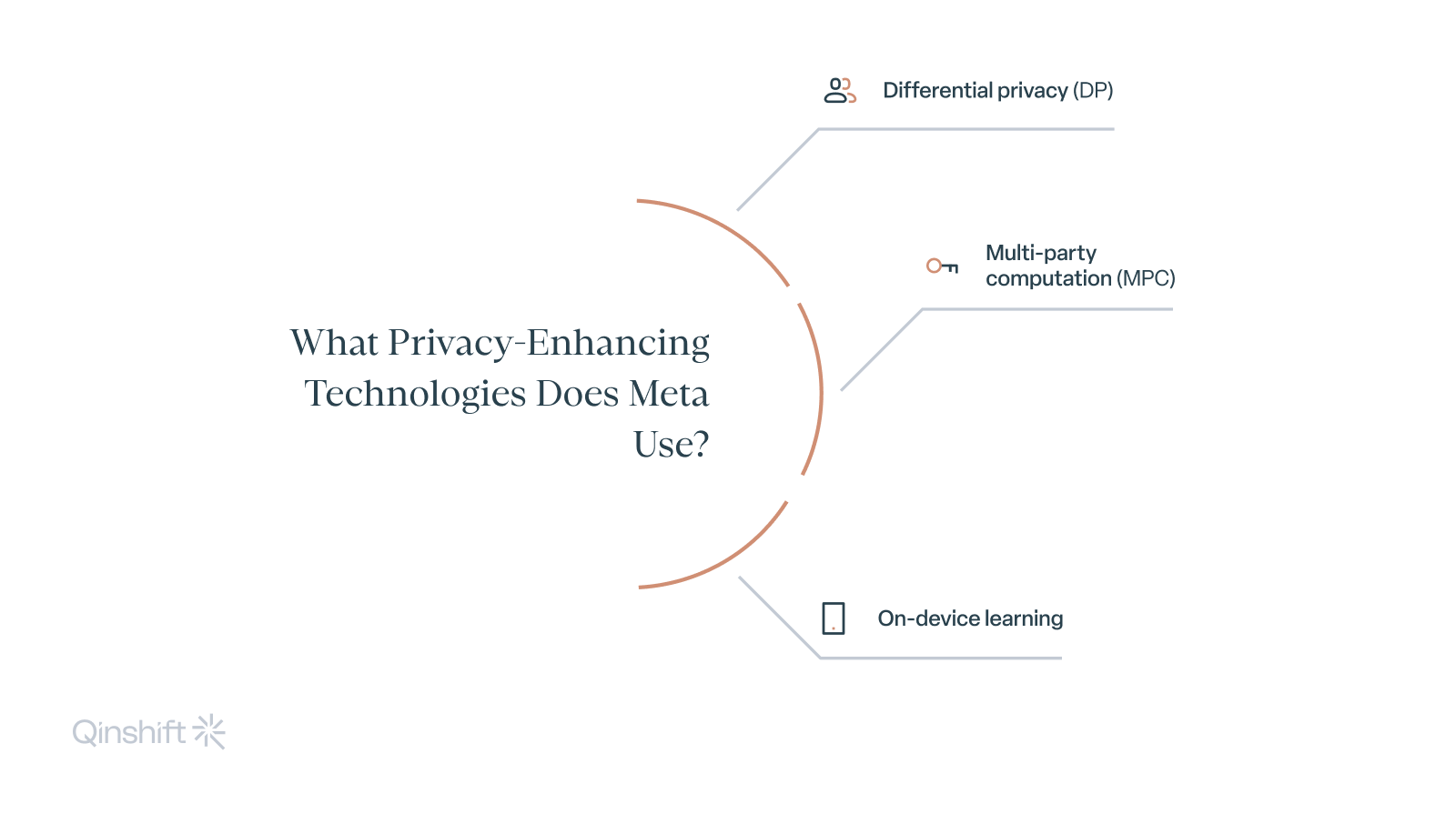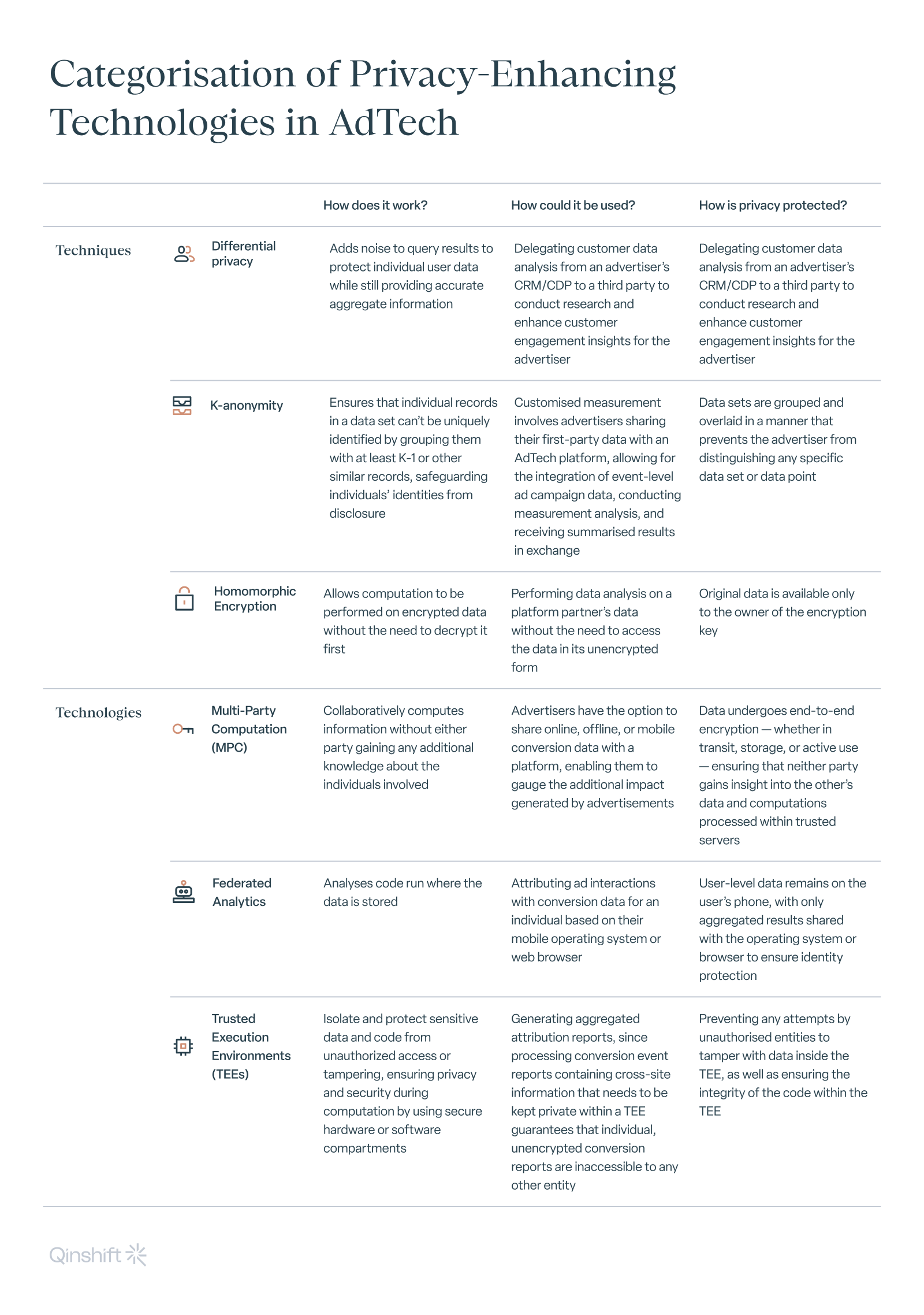How Meta Uses Privacy-Enhancing Technologies (PETs) in AdTech

Despite increasing privacy-related controversies, Meta, one of the world’s leading social media companies, understands the growing importance of safeguarding user information.
They adopt privacy-enhancing technologies (PETs) in their advertising solutions to meet regulatory and ethical standards.
In this article, you’ll learn about:
-
the privacy-enhancing technologies Meta has adopted,
-
Meta’s advertising solutions adjusting to security demands,
-
the future of PETs that Meta forecasts.
Key Points
-
Meta uses various privacy-enhancing technologies to protect user privacy, such as differential privacy or secure multi-party computation.
-
Meta’s advertising solutions that use privacy-enhancing technologies are Variance Reduction System and Private Lift Measurement. The company also incorporates PETs into their other products.
-
Together with Deloitte, Meta created a report on the future of PETs in AdTech. Market leaders predict that the digital advertising landscape will pivot toward privacy, and there will be a need to create a unified front to adopt PETs.
How Does Meta Adopt Privacy-Enhancing Technologies?
Incorporating privacy-enhancing technologies is complex, but Meta invests in a multi-year effort with academics, global organisations, and developers to build proper solutions and best practices.
There are three areas that the company primarily focuses on.
The first area is data use cases. Meta’s experts try to address advertisers’ most important uses of data with PETs. To do that, they’ve been working with industry groups, such as W3C and PRAM, to develop lists of use cases for discussion and encourage more industry partners to share their perspectives.
The second area is proposals — what advertising solutions can Meta create to enable essential uses of data while leveraging privacy-enhancing techniques?
The third area is feedback. The company actively seeks constructive feedback to enhance existing proposals.
Below you’ll find examples of how Meta has implemented PETs into their platforms and advertising systems.
-
Differential privacy in Variance Reduction System (VRS)
-
Multi-party computation in Private Lift Measurement
-
On-device learning on Facebook

Differential Privacy in Variance Reduction System (VRS)
In 2023, Meta launched Variance Reduction System (VRS) — a method of ensuring an equitable distribution of ads on Meta’s services. The system was built using differential privacy, a privacy-enhancing technology that ensures the privacy of individuals in data sets.
The VRS’s background stems from a lawsuit against Meta filed by the US Department of Justice for engaging in discriminatory targeting in housing ads. The platform enabled advertisers to use targeting based on protected characteristics like ethnicity, religion, and gender, creating an ad tool called Lookalike Audience that utilised a machine learning algorithm to identify users resembling selected groups, thereby allowing housing ads to be delivered based on these characteristics.
To meet the DOJ’s settlement agreement, Meta included differential privacy in implementing Bayesian Improved Surname Geocoding (BISG), a widely used measurement method, in VRS.
The company is now working on expanding the system to employment and credit ads.
Multi-Party Computation in Private Lift Measurement
Meta rolled out Private Lift Measurement (PLM), a tool for advertisers to help them understand customer acquisition costs on Facebook and Instagram.
With PLM, advertisers can measure the worth and incremental number of conversions without sharing consumer-level data between two parties.
Meta incorporated secure multi-party computation (MPC) into Private Lift Measurement to ensure that:
-
data shared between parties stays safe, secure, and separate;
-
all entities involved in advertising understand what works within ad campaigns;
-
advertisers use anonymised and grouped insights to keep ads relevant.
On-Device Learning on Facebook
Meta detects user behaviour patterns to increase the relevance of delivered advertisements. For this purpose, the company uses on-device learning, a privacy-enhancing technology that allows algorithms to learn directly on a user’s device. The process is carried out without sending specific individual data, like purchase history or email addresses, to remote servers or the cloud.
To illustrate how on-device learning works, here is an example. People who click on sports equipment ads also tend to purchase protein shakes. The algorithm can detect this pattern, learn on the users’ devices without sharing individual data with Facebook’s servers, then display ads with protein shakes to a relevant audience.
This privacy-oriented algorithm works similarly to autocorrection or text prediction — it improves over time by detecting patterns on numerous devices. Moreover, it can be further protected by combining it with differential privacy.
How Does Meta See the Future of Privacy-Enhancing Technologies in AdTech?
The digital advertising landscape is constantly evolving. With Apple and Google leading the charge in redefining privacy standards through their browsers and operating systems, the traditional reliance on individual third-party data is diminishing.
This shift necessitates a fundamental reimagining of digital advertising, one that places user privacy and ethical data practices at its core.
Meta and Deloitte created a report highlighting the importance of industry-wide collaboration and establishing shared standards for privacy-enhancing technologies.
Meta’s call to action resonates throughout the industry, inviting platforms, publishers, developers, and stakeholders to work together to define the future of AdTech.
The report categorises privacy-enhancing techniques and technologies currently leveraged in the AdTech industry. It points out their usage, but also answers the question about the future of PETs in AdTech.

On a maturity curve, PET adoption is still in the early stages, but some trends have begun to emerge.
Consumers are increasingly aware of data usage, especially their personal information, which will drive brands’ need to focus on scaling first-party data.
As a result, brands will need to adapt their strategies and technologies to improve customer engagement and loyalty while enhancing data capture through advanced privacy-focused data systems and governance.
What also becomes clear is that within the evolving AdTech ecosystem, companies should choose between separate and unified attitudes toward building privacy-enhancing solutions.
The ecosystem’s probable evolution is towards multiple open web solutions and customised platform products, resembling the current AdTech landscape. However, suppose marketers, platforms, measurement partners, and brands lean into the discussion. In that case, there is a chance to develop industry guidelines and thus save money on adopting PETs in the AdTech area.

